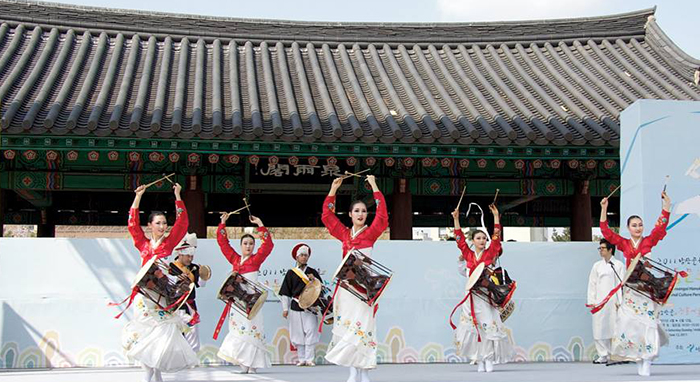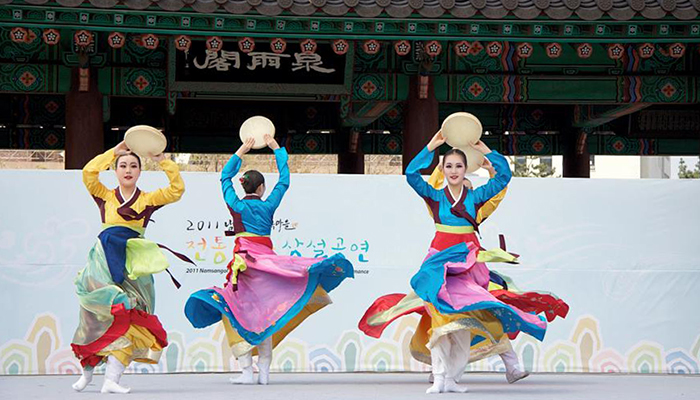You might already know that my PhD is about oral traditions and my focus lies
in East Asia, especially Korea.
I often come across people who are curious,
confused and sometimes even baffled that I’d write and study about
Korea.
Most of them associate “Korea” with the Hallyu Wave (KDramas, KPop),
cosmetics and politics – and don’t even think about the traditional music of
Korea which has a variety of genres.That’s why I played around with the thought
of making a brief beginner’s guide for people who plan on visiting Korea… and
here it is!
What is Gugak?The term gugak translates
into “national music” and comprises roughly of two bigger genres, folk music and
court music.
While court music includes ritual and aristocratic music like
aak (imported from China), dang-ak (a fusion between Chinese and Korean court
music) and hyang-ak (purely Korean), the folk music has p’ansori (vocal), sanjo
(instrumental music), jeong-ak (instrumental and vocal music), nongak (“farmers’
music”, drumming, dancing, and singing), shinawi (shamanistic music) and
salpuri (dance, related to shaman rituals).
Today, we also have newer
additions to Korean Music, Changjak-gugak or Shin-gugak, newly-composed Korean
traditional music and fusion gugak, with western elements.
I would like to
give you a general overview of Korean Traditional Music and focus on two
interesting topics, P’ansori and Fusion Gugak afterwards.
Hopefully, this
article will give assistance to first time readers as well as gugak
lovers.
InstrumentsOne unique aspect of Korean folk music you
will come across, is the freedom a master musician possesses during the
performance.
Improvisation during a concert, be it as soloist or ensemble, is
allowed and depend on the personal preference of the musicians.
Popular
instruments in Korean Traditional music are the plucked zither gayageum, fiddle
haegeum, bamboo flute daegeum, hourglass-shaped drum janggu, which is the most
prominent rhythm instrument in Korean music.
Inspired by the western
orchestra, there are also orchestra like formations with traditional instruments
in Korea, including a conductor.
Rhythm and TheoryOne unique aspect of Korean folk
music you will come across, is the freedom a master musician possesses during
the performance.
Improvisation during a concert, be it as soloist or
ensemble, is allowed and depend on the personal preference of the
musicians.
The basic rhythm in folk music are called jangdan (can also mean
tempo, accent) and while they follow set patterns, it is expected that a skilled
artist is able to improvise individually, using the patterns as foundation.
Most used patterns are: jinyang (slow), jungmori (medium), jungjungmori
(medium-fast), jajinmori (fast) and hwimori (very fast).
Referring the the
“modes” in Korean Traditional Music, there are many “modes” for example in
p’ansori, since a musical piece is not characterised through keys or mode but
rather the nature of the melody itself.
Two essential and basic modes you’ll
find in Korean Traditional Music are called gyemyeonjo (sad style) and ujo
(majestic), both use a five-pitch scale without semitones (anhemitonic
pentatonic scale).
*Sample video
here.
Places to visitIf you are in Seoul, the National
Gugak Center and the National Theater of Korea are the best places to catch a
live performance by a master artist.
Both institutions have english websites
with ticket hotlines, but usually you can get tickets on site without any
problems.
Another interesting tip: the website of Gugak FM features video
clips and daily radio broadcasts (some of them in English) and provides the
latest news from the world of Gugak.
Universities with an own Gugak
department also host regular concerts of students and masters.
Let’s talk about P’ansoriP’ansori became internationally
recognized in 2003 as a Masterpiece of the Oral and Intangible Heritage of
Humanity by the UNESCO.
It is being performed by a solo singer
(
sorikkun) and a drummer (
gosu) and was formerly considered as
an entertainment for the lower class, until the patronage by the yangban (upper
class) made p’ansori popular.
Today, there are five surviving P’ansori, Chunhyangga, Simcheongga,
Heungbuga, Sugungga and Jeokbyeokka and each one of them conveys are different
message to the audience.
Previously the songs of one p’ansori were performed
throughout the whole day or only pieces of it, as entertainment for a banquet or
celebration for passing a government exam, but at the present day people expect
a p’ansori performance by a master singer to be complete, hence performances can
last between three to eight hours (with small breaks of course).
The five P’ansoriChunhyangga is a romantic
love story about a woman, who endures hardships and stays faithful until her
lover returns. Their relationship is not an usual one, as she is the daughter of
a gisaeng (female entertainer) and he is of noble birth.
This famous story
was retold in movies for the cinema and also in a modernized TV Series,
Sassy Girl Chun Hyang.
Simcheongga emphasizes filial piety in showing the audience the
sacrifice the girl Simcheong makes to give her blind father his eyesight
back.
To regain his sight, the father promises a wandering monk hundred sacks
of rice but because he is as poor as a beggar and can’t fulfill his promise to
the monk, his daughter Simcheong sells herself to fishermen who are in need for
a sacrifice for the water god.
Heungbuga teaches confucian family values (the rightful order within
a family) with the story of two brothers.
While the poor, younger brother is
rewarded with riches for his honest life after he mends the broken leg of a
swallow, the older brother who inherited the family fortune falls into disgrace
after he purposely breaks the leg of a swallow to gain the same riches as his
younger brother.
Sugungga is a witty tale about a rabbit, who escapes from
the underwater palace, after he got caught to get his liver sacrificed to the
sick dragon king.
After convincing the king that he forgot his liver on land,
rabbit manages to save his life.
Jeokbyeokka is the re-telling of the famous Chinese tale the “Red
Cliff” and displays warfare, the code of honor between men, the lifes of
soldiers and generals.
It is said, that Jeokbyeokka is the most difficult
p’ansori to master, both in technique and understanding of the story.
*Sample video
here.
Experience itOne of the most
important things in a p’ansori performance is the interaction with the
audience.
To support the singer and to voice their opinion to the ongoing
story on stage, listeners are encouraged to participate actively while listening
to the music through
chuimsae (encouragement), the most common
exclamatory remarks are:
eolshigu! and
joota!, both mean
“great”, “good” and general agreement to the scene the musician describes.
If
you visit a p’ansori performance, don’t be shy and try to participate in the
chuimsae too.
But be aware, that not every scene is fit to receive an
encouraging remark; if for example the hero or heroine is in duress or in need,
you should avoid cheering by shouting eolshigu!
Try to follow the story if
you understand Korean or if subtitles are provided, or take an experienced,
fellow audience member as an example for your first steps in chuimsae.
Some
performances, tailored for foreign audience also provide introductions and
instructions.
Anyway, if you have enjoyed p’ansori with our heart, make sure
to encourage the singers with heartfelt clapping after the concert!
Where to goNational Gugak Center (
http://www.gugak.go.kr/eng/index.jsp)
National Theater of
Korea (
http://www.ntok.go.kr/english/)
And what about Fusion Gugak?Fusion Gugak is not to
be confused with
Changjak-gugak or
Shin-gugak, which means
newly-composed Korean traditional music.
While Changjak-gugak stays faithful
to its roots in traditional theory and forms, Fusion Gugak experiments with
western popular music, be it in instrumentation, usage of synthesizer or even
dance.
Highly popular are musicals like Miso, with a storyline from Korean
folklore and a combination of korean and western music and formations like
SOREA, a girl group-esque ensemble, comprised of players of the gayageum,
haegeum, daegeum, kkwaenggwari (small, flat gong), janggu, who speak to a
younger audience in and outside of Korea with their rigorously choreographed
performances and attractive looks.
Soundtracks of Korean TV Dramas (OST),
often include Fusion Gugak and official institutions, such as the KTO (Korea
Tourism Organization) use the music of Fusion Gugak to introduce Korea to
foreigners.
But there are also other trends within Fusion Gugak, the group AUX
experiments with western instruments, such as keyboards and drums and gives us
unique sounds outside the mainstream, much like a indie band – but originating
from Korean Music.
AUX won the Grand Prize in 2010 at the prestigious Korean Music Project and
in 2011 they represented Korea at the competition Asian Beat by Yamaha.
Have
a peek at their unique style in the video
here!
Believe me, when I tell you that this article only scratched the surface.
Korea’s traditional music -be it court or folk music- is like a treasure chest
and sometimes, unexpected gems can be found in it.
I hope you got interested in watching a performance yourself!
source:
http://www.korea.net/NewsFocus/Culture/view?articleId=111648


























